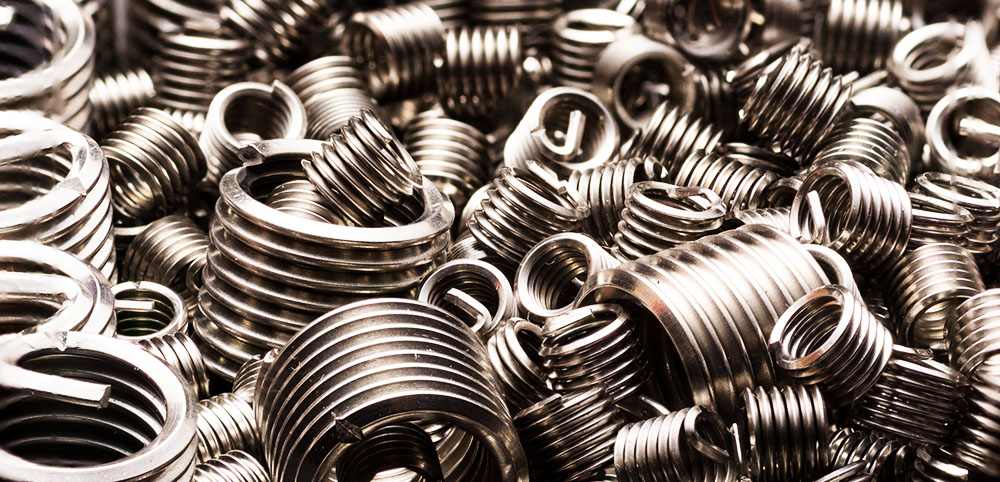Threaded inserts play a crucial role in CNC machined prototypes, providing a reliable and durable solution for creating threaded connections in a variety of materials. However, it is important to understand when and why threaded inserts should be used in CNC machined parts prototypes.
What Is Threaded Inserts
A threaded insert is a cylindrical metal component with a threaded interior that allows the attachment of bolts, screws, or other threaded fasteners to connect one component to another. They are particularly useful in equipment that requires frequent disassembly and reassembly, or when working with softer materials that may not provide sufficient strength for direct threading.
There are different types of threaded inserts available, each with its own unique characteristics and applications. One commonly used type is a helical insert, also known as a helical coil. The spiral insert has a diamond-shaped cross-section and is made from high-grade stainless steel wire. They are mechanically rolled into a spring-like threaded shape, providing superior strength and durability.
Benefits of Threaded Inserts
1. Enhanced Thread Integrity:
Threaded inserts offer superior thread integrity compared to directly machining threads into the material. This is particularly important in materials with lower machinability or those prone to thread wear.
2. Material Compatibility:
CNC machining can be applied to a wide range of materials, including metals, plastics, and composites. Threaded inserts enable the creation of threads in these materials without compromising their structural integrity.

3. Versatility in Material Selection:
Threaded inserts accommodate the use of different materials for the insert and the host material. This versatility is advantageous when specific material properties are required for the threaded portion or the surrounding structure.
4. Repairability:
In prototypes, design iterations are common, and threaded inserts facilitate ease of repair or replacement. If there’s a need to modify or re-thread a section, it can be done by replacing the insert without affecting the entire part.
5. Thread Reinforcement:
In materials that might be prone to thread stripping or wear, threaded inserts act as a reinforcement, ensuring that the threads maintain their integrity over multiple uses or disassemblies.
6. Corrosion Resistance:
For applications where corrosion resistance is crucial, using a corrosion-resistant threaded insert material can be advantageous. This is especially relevant in prototypes that may be exposed to harsh environmental conditions.
7. Thermal Considerations:
In CNC machined prototypes that will experience thermal cycling or high temperatures, threaded inserts made from materials with better thermal stability can be employed to ensure consistent performance.
8. Reduced Machining Complexity:
Machining internal threads directly can be challenging, especially in certain materials. Threaded inserts simplify the machining process, making it more straightforward and efficient.
Factors to consider
While threaded inserts offer many advantages, there are certain factors to consider before deciding to use them for CNC machining prototypes:
Cost:
Threaded inserts may increase the overall cost of the prototype due to the price of the insert itself and additional installation fees. It’s important to evaluate your budget and determine whether the benefits outweigh the costs.
Lead time:
Installation of threaded inserts may require additional time, especially in large-scale production. It is crucial to consider lead times and their impact on project timelines.
Material Compatibility:
Threaded inserts may not work with all materials. While they work well with softer materials, they may not provide enough strength for some applications or materials. It is important to evaluate the compatibility of threaded inserts with the specific materials used.
Alternative solutions:
In some cases, alternative solutions such as standard drilling and tapping may be more cost-effective and functional for CNC machined prototypes. It is critical to evaluate different fastening methods and select the one that best meets the project requirements.
When to use threaded inserts
Threaded inserts are best suited for CNC machining prototypes when:
Frequent disassembly and reassembly:
If the prototype will be disassembled and reassembled frequently, threaded inserts will provide a reliable and durable solution. They allow bolts or other threaded connections to be easily removed and reinserted without damaging the component.
Soft Materials:
When using soft materials like aluminum or plastic, threaded inserts add strength and durability. They prevent threads from becoming stripped or damaged, extending the life of your prototype.
Applications requiring strength and stability:
Threaded inserts are ideal for applications requiring a strong, stable connection. They provide additional strength to load-bearing areas and prevent fasteners from loosening, making them suitable for aerospace, defense and other high-stress applications.
Repair Damaged Threads:
If a prototype has damaged internally threaded holes, threaded inserts can be used to repair and restore functionality to the threads. This avoids the need to scrap or replace the entire assembly, saving time and resources.



